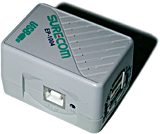
Surecom EP-1004 four port USB hub
Review date: 6 May 1999. Last modified 03-Dec-2011.
USB hubs are pretty simple appliances, and there's only so much a manufacturer can do with them. They can be basic beige (like this one) or funky blue (like this one) or built into a monitor, but the essential function is the same - one USB cable in, four (usually) USB ports out. Little lights, maybe.
You plug it in and it works. One USB port becomes four. Or, if you're running a USB-unaware operating system, like pretty much anything but current Windows 98, very late model Windows 95 or current MacOS, you plug it in and it doesn't work.
One would think there'd be little room for market segmentation, here.
It's the little differences...
Surecom's EP-1004 has its own little claim to fame - it's small. Weeny. Teeny-tiny. About 55 by 39 by 35mm (2.1 by 1.5 by 1.3 inches), to be exact. There's barely enough room on the thing for the two USB output ports on each end, each of which is supplied with a green "ready" and red "overcurrent" LED. The input port's on one side, with its own power light, and that's it. The gizmo sells for about $75 (Australian dollars), which is significantly cheaper than the cool looking Skymaster hub I reviewed recently. Naturally, it comes with the the A-to-B cable needed to plug it in.
The down side is that this is a pure "bus powered" hub, with no power supply of its own. This means it can only supply a total of 500mA of current to the four devices that can plug into it, and also means other hubs can't be "cascaded" from any of its ports. Larger hubs are usually dual mode - they're bus powered if you don't plug their included AC adaptor in, to make them self powered.
For most users, a bus powered hub is fine. Most USB devices have their own power supply, or draw very little current (USB mouses and keyboards are very frugal), and you actually have to look pretty hard for anything that'll stress a bus powered hub.
Overall
Is this an exciting product? Well, no. But if you're looking for a USB hub, and you don't need a self powered one, and you wouldn't mind having something roughly the size of a couple of stacked boxes of matches, as opposed to something the size of the average modem, then this would appear to be the hub for you. And it doesn't hurt that it's $25 or so cheaper.


